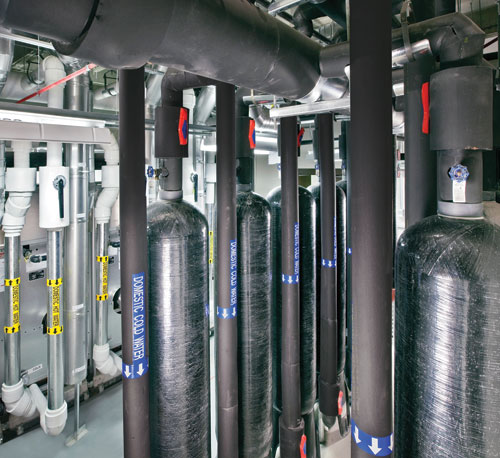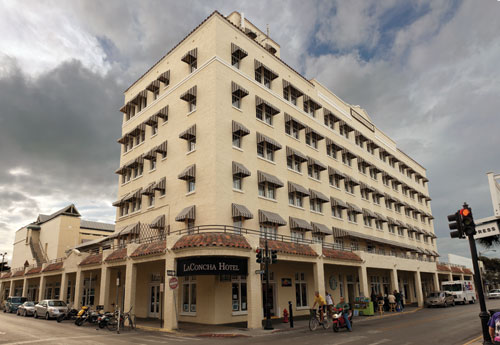Template-Assisted Crystallization
Physical water treatment systems (PWT) are alternative or unconventional ways to treat water in order to prevent the damage caused by hard water scale. The advantages of these technologies are that they help the environment. They do not include a salt regeneration or discharge into the wastewater systems. PWT technologies are based on a variety of ways to transform water molecules through magnetic, electrostatic, capacitive, catalytic, or by transforming hardness into a non-scale forming microscopic crystal through template-assisted crystallization. Among the physical water treatment systems, template-assisted crystallization (TAC) excels in scale prevention and meets even the most stringent environmental standards.

Photo courtesy of Watts
Multiple TAC units provide all of the water conditioning needed for this large project in a space smaller than required for a traditional water softening unit.
Greg Reyneke, CWS-VI, general manager at Intermountain Softwater, recommends a smart design approach to water quality and water management in building design. He has been involved in water treatment for nearly 20 years. He proposes a layered approach to the design of water systems and recommends that the first step for any project designer is to test water quality and determine how to condition the water for use. “Due to economic and environmental concerns, a multi-layered approach is necessary to provide the best balance of performance and cost while satisfying the needs of the customer. Water conditioning using template-assisted crystallization provides the most environmentally friendly solution for the prevention of hard water scale in commercial and residential buildings.”
This article will focus on template-assisted crystallization (TAC) water conditioning systems and current research that demonstrates the effectiveness of TAC to prevent scale without degradation of the water quality. The driving force for TAC in the marketplace was to offer to design professionals a green technology that would:
- Reduce scale and the negative effects of hard water
- Save energy
- Require no discharge water, regeneration, wastewater or disposal costs
- Have zero pollution
- Minimize capital investments, ongoing maintenance and operational costs
TAC is primarily used to minimize the problems associated with hard water in distribution systems, appliances and equipment that generate or use hot water. All PWT systems claim to utilize technologies that influence the physical characteristics of the solution being treated. By using TAC, scale reduction is accomplished without removing or adding anything to the water. The result is water quality that is rich in beneficial minerals while the properties that produce scale are rendered harmless.

Photo courtesy of Watts
This large hotel in Key West, Florida, protects its mechanical system from scale and premature failure with a TAC water conditioning unit.
Using a TAC water conditioning system is the first step in sustainable planning for green building ratings. Environmental benefits include:
- Reduction of pollution from wastewater in buildings
- Reduction of water use from 20 to 30 percent in buildings as there is no back washing, no regeneration, no brine fill or brine rinse as compared to conventional commercial water softeners
- Reduction of mechanical room size because of smaller tanks and the lack of a need to store salt, a non-renewable resource
- Prevention of scale accumulation on equipment and piping, which maintains peak energy efficiency, reduces water use and eliminates costly equipment cleaning
TAC systems are over two-thirds smaller than conventional water conditioning systems and there is no need to purchase or store salt. Many water experts are using TAC as the first line of defense against harmful scale in both new and existing buildings. They are receiving credits in green building rating systems because of the environmental advantages of TAC.









